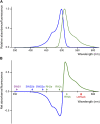Changes in a Cone Opsin Repertoire Affect Color-Dependent Social Behavior in Medaka but Not Behavioral Photosensitivity
- PMID: 32903371
- PMCID: PMC7434946
- DOI: 10.3389/fgene.2020.00801
Changes in a Cone Opsin Repertoire Affect Color-Dependent Social Behavior in Medaka but Not Behavioral Photosensitivity
Abstract
Common ancestors of vertebrates had four types of cone opsins: short-wavelength sensitive 1 (SWS1), SWS2, rhodopsin 2 (RH2), and long-wavelength sensitive (LWS) types. Whereas fish and birds retain all the types, mammals have lost two of them (SWS2 and RH2) possibly because of their nocturnal lifestyle during the Mesozoic Era. Considering that the loss of cone opsin types causes so-called color blindness in humans (e.g., protanopia), the ability to discriminate color by trichromatic humans could be lower than that in potentially tetrachromatic birds and fish. Behavioral studies using color-blind (cone opsin-knockout) animals would be helpful to address such questions, but it is only recently that the genome-editing technologies have opened up this pathway. Using medaka as a model, we introduced frameshift mutations in SWS2 (SWS2a and/or SWS2b) after detailed characterization of the loci in silico, which unveiled the existence of a GC-AG intron and non-optic expressed-sequence-tags (ESTs) that include SWS2a in part. Transcripts from the mutated SWS2 loci are commonly reduced, suggesting that the SWS2a/b-double mutants could produce, if any, severely truncated (likely dysfunctional) SWS2s in small amounts. The mutants exhibited weakened body color preferences during mate choice. However, the optomotor response (OMR) test under monochromatic light revealed that the mutants had no defect in spectral sensitivity, even at the absorbance maxima (λmax) of SWS2s. Evolutionary diversification of cone opsins has often been discussed in relation to adaptation to dominating light in habitats (i.e., changes in the repertoire or λmax are for increasing sensitivity to the dominating light). However, the present results seem to provide empirical evidence showing that acquiring or losing a type of cone opsin (or changes in λmax) need not substantially affect photopic or mesopic sensitivity. Other points of view, such as color discrimination of species-specific mates/preys/predators against habitat-specific backgrounds, may be necessary to understand why cone opsin repertories are so various among animals.
Keywords: color discrimination; medaka (Oryzias lapites); reverse genetics; sensory drive; short wavelength sensitive gene; spectral sensitivity.
Copyright © 2020 Kanazawa, Goto, Harada, Takimoto, Sasaki, Uchikawa, Kamei, Matsuo and Fukamachi.
Figures





Similar articles
-
Behavioral photosensitivity of multi-color-blind medaka: enhanced response under ultraviolet light in the absence of short-wavelength-sensitive opsins.BMC Neurosci. 2023 Dec 14;24(1):67. doi: 10.1186/s12868-023-00835-y. BMC Neurosci. 2023. PMID: 38097940 Free PMC article.
-
Protanopia (red color-blindness) in medaka: a simple system for producing color-blind fish and testing their spectral sensitivity.BMC Genet. 2017 Feb 6;18(1):10. doi: 10.1186/s12863-017-0477-7. BMC Genet. 2017. PMID: 28166717 Free PMC article.
-
Phylogenetic analysis and ontogenetic changes in the cone opsins of the western mosquitofish (Gambusia affinis).PLoS One. 2020 Oct 13;15(10):e0240313. doi: 10.1371/journal.pone.0240313. eCollection 2020. PLoS One. 2020. PMID: 33048954 Free PMC article.
-
Losses of functional opsin genes, short-wavelength cone photopigments, and color vision--a significant trend in the evolution of mammalian vision.Vis Neurosci. 2013 Mar;30(1-2):39-53. doi: 10.1017/S0952523812000429. Epub 2013 Jan 3. Vis Neurosci. 2013. PMID: 23286388 Review.
-
S cones: Evolution, retinal distribution, development, and spectral sensitivity.Vis Neurosci. 2014 Mar;31(2):115-38. doi: 10.1017/S0952523813000242. Epub 2013 Jul 29. Vis Neurosci. 2014. PMID: 23895771 Review.
Cited by
-
Dietary carotenoids enhance SWS1 expression in female western mosquitofish (Gambusia affinis) but do not impair their likelihood of pregnancy in the presence of male guppy.J Comp Physiol A Neuroethol Sens Neural Behav Physiol. 2025 Jul;211(4):411-423. doi: 10.1007/s00359-025-01741-w. Epub 2025 Apr 29. J Comp Physiol A Neuroethol Sens Neural Behav Physiol. 2025. PMID: 40299003
-
Validation of the three-chamber strategy for studying mate choice in medaka.PLoS One. 2021 Nov 15;16(11):e0259741. doi: 10.1371/journal.pone.0259741. eCollection 2021. PLoS One. 2021. PMID: 34780539 Free PMC article.
-
Knockout of sws2a and sws2b in Medaka (Oryzias latipes) Reveals Their Roles in Regulating Vision-Guided Behavior and Eye Development.Int J Mol Sci. 2023 May 15;24(10):8786. doi: 10.3390/ijms24108786. Int J Mol Sci. 2023. PMID: 37240129 Free PMC article.
-
CRISPR/Cas9-mediated generation of biallelic F0 anemonefish (Amphiprion ocellaris) mutants.PLoS One. 2021 Dec 15;16(12):e0261331. doi: 10.1371/journal.pone.0261331. eCollection 2021. PLoS One. 2021. PMID: 34910772 Free PMC article.
-
Sws2 Gene Positively Regulates Melanin Production in Plectropomus leopardus Skin via Direct Regulation of the Synthesis of Retinoic Acid.Int J Mol Sci. 2024 Jul 9;25(14):7513. doi: 10.3390/ijms25147513. Int J Mol Sci. 2024. PMID: 39062755 Free PMC article.
References
LinkOut - more resources
Full Text Sources
Research Materials
Miscellaneous

